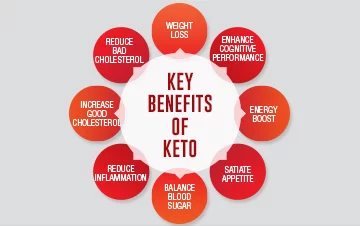This is a scientifically proven, extremely low carbohydrate diet which cuts out sugar. It is specifically beneficial to epileptics and type 2 diabetics. It might not be a solution for everyone, but it does have a reputation for weight-loss.
How Does it Help Weight Loss?
This diet works by convincing the body and brain to burn the fat from fat cells for energy. This is called ketosis which is a natural metabolic state and studies have proven it increases insulin levels which help move glucose into the bloodstream. It is a diet which utilizes minimal carbs, high fat, and moderate protein.
Rare Cases
These are extremely uncommon side effects which have been reported:
- Increased cholesterol levels – LDL (Low-Density Lipoprotein), as well as total cholesterol levels, were measured and reported as higher by some individuals.
- Kidney stones – some epileptic children have reported developing kidney stones while on this diet.
- Ketoacidosis – reported by breastfeeding women.
Transitioning From Low-Carb to Ketogenic Diet
Allow your body to adapt to a low-carb diet such as the Atkins Diet before moving onto the ketogenic diet. It may not eliminate side effects, but will definitely prepare your body in advance.
Short-Term Side Effects vs Long-Term Side Effects
Short-term side effects and treatment method:
- Tiredness – add maca powder to your diet.
- Nauseousness – add ginger to your diet.
- Difficulty sleeping – add a few drops of lavender oil to your pillow.
- Elevated hunger – space meals out as evenly as possible and keep them small.
- Difficulty thinking clearly – stock up on blueberries as these improve focus.
- Headaches – stock up on magnesium-rich foods such as bananas and seeds.
These symptoms are similar to those experienced during a bout of the flu and so, have been nicknamed the Keto-flu. The withdrawal from sugary foods and carbs as well as the lack of electrolytes and dehydration are what cause the Keto-flu, however, it should only last a couple days.
Long-term side effects and treatment method:
- Keto-breath – As ketosis occurs, blood-acetone levels are raised and this makes acetone present in the breath. Try adding parsley to season your food.
- Leg cramping – Eat magnesium and potassium rich foods such as spinach and pumpkin seeds.
- Constipation and diarrhea – Although constipation is more likely, the digestive system tends to come to a stand-still without the fiber it has become accustomed to. Be sure to eat as many low-carb veggies and berries as possible.
- Dehydration – Commit to drinking 2 litres of water a day.
- Heart palpitations – Add salt to your food.
To Sum Everything Up
With the understanding that not everyone’s body is the same so there is a risk that is taken when committing to any diet. While the ketogenic diet has been mostly reported at actually lowering the amounts of seizures for epileptic individuals, it has also had a few negative reports about having caused kidney stones for other epileptic individuals. If you can make it through the Keto-flu and follow the treatment methods for all of the known side effects, weight-loss should be the result after some time and moderate exercise.
Do you want to find an effective Keto treatment? Check out our top rated Keto products












